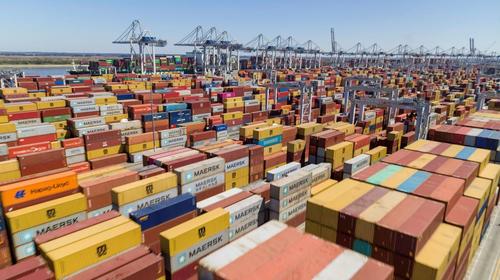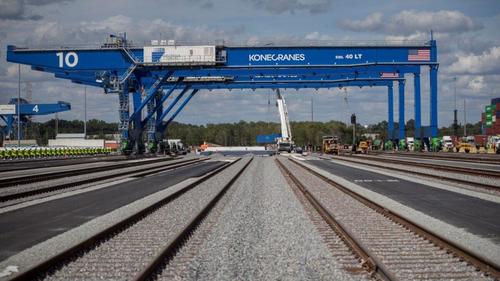Authored by Charles Hugh Smith via DailyReckoning.com,
One of the most famous examples of smart people being sucked into a bubble and losing a packet as a result is Isaac Newton’s forays in and out of the 1720 South Sea Bubble that is estimated to have sucked in 80–90% of the entire pool of investors in England.
Some have claimed that Newton did not buy early in 1711, sell in April 1720 for a nice profit and then sink the majority of his substantial fortune in the bubble as it peaked in summer, then suffering heavy losses as the bubble popped in September, but evidence supports this chain of events.
Newton “bought the dip” on the way up and then added to his position as the mania rolled over, making his final fatal purchase as a “buy the dip” just before the “last chance to exit” spike — which is precisely the point the current bubble has finally reached, when everyone is all in and “buying the dip” to increase the profits that everyone agrees are essentially guaranteed because the Fed.
Not Even a Genius Can See a Bubble
Isaac Newton was a very smart man. Newton was not just smart and wealthy, but he was financially sophisticated and a very successful investor who favored financial instruments such as bonds over land.
He was the ultimate experienced, savvy investor who would not be bamboozled by specious math.
The problem is, alas, smart people are still humans, and humans run with the herd when the herd is minting money.
The Herd Is in for a Rude Awakening
Absurdly farfetched claims are gussied up with “mathiness” and narratives that are powerfully simplistic, with just enough common-sense credibility to enliven the excessive greed that lies dormant but ready in every human heart.
Despite Newton’s tremendous intelligence and experience, he fell victim to the bubble along with the vast herd of credulous greedy punters.
Newton died a wealthy man in 1727, so his bubble misadventure did not ruin him, though it did lop a huge chunk off his net worth.
Many in the herd, then and now, won’t be as fortunate. In fact, right now they’re being set up for a massive fall. And the financially intelligent could make fortunes as a result.
Let me explain…
An Opportunity to Scoop up Mega-Millions
An extraordinary opportunity to scoop up mega-millions in profits has arisen, and grabbing all this free money makes perfect financial sense. Now the question is: Will those who have the means to grab the dough have the guts to do so?
Here’s the opportunity:
Retail punters (those who attempt to make fast profits from an investment regardless of its underlying fundamentals) have gone wild for call options, churning $2.6 trillion in mostly short-term calls — bets on gains now, not later.
This expansion of retail options exposure is unprecedented not just in its volume but in its concentration in short-term bets (options that expire in a few days) and in mega-cap tech companies that are commanding rich premiums for options.
The options market is like every other market only more so.
The price of an option — a bet that a stock, ETF or index will go up or down before the option expires — is sensitive to the volatility of the underlying equity, the demand of other punters for options and the premium being demanded for time:
The further out the expiration date, the higher the cost of the option.
Anyone with 100 shares of the underlying equity can write/originate an option. Each option controls 100 shares, so a call option that is listed at $1 costs the buyer of the call $100.
This is very sweet leverage if the market goes your way. You get all the gains of the 100 shares for a cost considerably less than buying the 100 shares outright. No wonder retail punters are going crazy for this cheap leverage to maximize gains in “can’t lose” trades.
There’s a Catch
But options have one funny trait: They can expire worthless and the punter loses the entire bet.
Each option has an expiration date and a strike price — the price of the underlying equity that’s the pivot point for the bet.
Calls gain value if the equity’s price moves above the strike price and puts gain value if the equity’s price falls below the strike price.
The entity that sold the option gets to keep the money if it expires without any value. Here’s an example:
Let’s say you have 100 shares of Engulf & Devour and you sell me a call for $500 at a strike price of $100. If Engulf & Devour closes below $100 at expiration, you keep the $500 as pure profit and I lose the entire bet.
Now, it would be extraordinarily profitable to sell a huge number of calls — bets on a move higher — and then pull the rug out by crashing the market just as all those options expire. It would be criminally foolish not to crash the market and scoop up all that free money.
Here’s what makes the opportunity so extraordinary…
All Bulls, No Bears
The options universe is extremely lopsided. Bearish bets have dried up as the market has melted higher month after month; short bets are at record lows and the put-call ratio reflects the same capitulation of bears and bulls’ supreme confidence in near-term gains.
This means a crash will cost very little in terms of puts gaining value because there are so few puts out there to reap enormous gains as the vast majority of call options will expire worthless, leaving those who wrote the calls immensely wealthier.
In previous eras with lower retail option volume and a less lopsided options market, it wouldn’t be worth the trouble to flash-crash the market to scoop up retail calls. But a trillion here and a trillion there and pretty soon you’re talking real money.
Buyers of “can’t lose” calls may be unaware that the tail can wag the dog. Mega-cap tech companies appear invulnerable to declines, but they are now the 800-pound gorillas in all the indexes (Dow 30, S&P 500, Nasdaq) and a boatload of ETFs.
So triggering a mass sell-off in an index play such as SPY will trigger a sell-off in all the components of that index, including the invulnerable mega-cap tech names.
Mass Exodus
The opportunity here is amplified by the dominance of computer trading algorithms. Once a crash begins, the algos will trend-follow and liquidate exposure to lower risk. This sets up a self-reinforcing chain of selling as every drop triggers more sell programs.
Volumes are so low that it won’t take that big of a leveraged sell order to start the rug-pull.
Add up the extraordinary size of retail options bets, the lopsided bullish bias in calls and the short duration of the calls and you have an unprecedented opportunity to scoop mega-millions of dollars by doing a rug-pull of the market via selling leveraged index instruments.
Retail call buyers are basically begging the big players to take their money via a flash crash, and the players would be insanely incompetent not to take the money lying on the table.
The Perfect Con
It has all the moving parts of a perfect con:
Convince the retail punters that they can’t lose by buying calls, jack up the premium they’re paying to own that beautiful leverage for a few days or weeks, lead them on with little rallies, “proving” they can’t lose and encouraging them to buy more high-priced calls, crush volatility to show the futility of buying puts and persuade the punters they have no need for any hedge, as the market can only loft higher because the Fed, etc.
Then bang, pull the rug out and crash the market limit down for a few days.

It’s a gorgeous setup, literally picture-perfect. It makes perfect financial sense to crash the market and no sense to reward the retail options marks by pushing it higher.
Let’s see who gets to be the Road Runner and who ends up as Wile E. Coyote.










